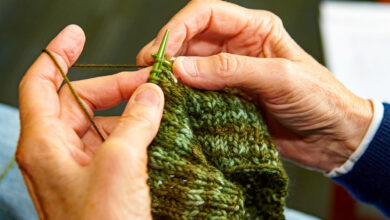Fine Art Dolls to Visit Alexandria in July
And Bring a Touch of Fantasy to Our City
By Kris Gilbertson
On July 18, the National Institute of American Doll Artists will convene its 2016 Conference and Doll Making School at the Sheraton Suites Old Town at 801 N. St. Asaph Street. Doll making classes, open only to conference attendees, are scheduled for the first three days. But what happens after that will bring a measure of magic to Old Town.
NIADA was founded in 1963 by a small group of doll artists, led by Helen Bullard of Tennessee. The doll community at that time only considered antique dolls to be art. Bullard organized her colleagues who were creating new dolls, and the group aimed to work together toward a common goal: recognition of original handmade dolls as fine art.
In the half century since, NIADA membership has grown to include more than 60 peer-elected artists from Europe, Japan, Korea, Russia, Australia, New Zealand, and U.S. states from New York to Hawaii. Subject matter ranges from realistic figures to anthropomorphic creations to somewhat abstract pieces that merely suggest the human form. But from the beginning in 1963 to present, every element of a doll must be created by the artist.
In much of the art world, their creations are now classified as figurative sculpture. There will be 27 artists attending the conference and displaying their sculpture, 25 to 30 patrons (doll art collectors or fans who volunteer), and many art doll enthusiasts.
A Very Nice Place to Meet
Alexandria is a new location for the conference, chosen at the suggestion of Juanita Zientara, a NIADA patron living in Arlington. She described Old Town as a “very art friendly, very nice place” to NIADA vice president and conference coordinator Susan Scogin. And when Scogin arrived last August to take our measure, she “absolutely fell in love.” Scogin booked the Sheraton Suites for the main conference, but was dismayed to find other potential facilities already booked solid through the 2016 summer.
The Torpedo Factory, in particular, would be ideal to demonstrate aspects of the doll making art to the public. Alas, it seemed there was no room at the Torpedo Factory. But Scogin was working with Michael Price, manager of corporate sales at the hotel (and who, she says, has been “absolutely wonderful”).
Price told Pat Miller (Torpedo Factory board member and Alexandria Living Legend) about the conference and Miller stepped in to help. She opened the doors to the Torpedo Factory for a pop-up workshop on Saturday, July 23. “This is something we have never done before,” says Scogin, “and we have always wanted to interact with the public in this way!”
Another NIADA first is that the artists will have a showing in the Principle Gallery at 208 King Street, on Thursday evening, July 21. Gallery director Clint Mansell admits that when Zientera and Scogin approached, he was astounded by the artistry and originality of the work, which he has so far seen only digitally.
“I could see that the gallery’s clients must like realism and detail,” says Scogin. “You can tell they appreciate technical skill by what’s hanging there and I thought, we’re going to fit in. We will have some dolls that are pretty far out on the edge as far as representational figures, but that’s what some of our artists do and they’re very, very good.”
Principle Gallery lives in the old Gilpin House bookstore, which has been transformed into a spacious venue ideal for displaying art. The dolls will be mounted on individual pedestals throughout gallery rooms.
The showing will be a public event, and Mansell has put the word out on Principle Gallery’s newsletter and social media, reaching tens of thousands of followers. “I no longer refer to them as dolls,” he says, “rather figurative sculpture. It’s not Cabbage Patch.”
The final opportunity for residents to see and possibly purchase the works of NIADA artists will come on Sunday, July 24, at the Artist Member Show and Sale at the Sheraton Suites Old Town. (See sidebar for details)
Membership Standards
NIADA is a small organization, and it is not easy to get into. As the premier group in its artistic area, it may receive up to a dozen applicants a year, but the application process is complex and difficult. To begin, an artist submits a portfolio of slides, an artist statement, and a resume. From this, the Standards Committee determines if the person’s work “is there.” If not, that’s the end of the process.
The Standards Committee isn’t interested in how much an artist may sell. They only measure by what is called “identity of design.” An applicant’s work must be unique and personal. If it seems derivative of someone else’s work, it is not accepted. Good technical skills are essential and commercial success is fine, but without identity of design, it’s no go.
Applicants who pass Part One must attend a conference and bring their work to be critiqued by a NIADA artist. Critiques can be rigorous, although Scogin says that they always find something positive to say. But she adds that it is almost unheard of for a critique to judge an artist’s work to be “fully formed, unique, perfect.”
The late Elizabeth Brandon, a renowned NIADA artist, applied seven times before being accepted. “Her work went from okay to fantastic,” says Scogin.
Once voted in as a NIADA member, you are never out, even if you move into a different artistic area, retire, or die. But NIADA is a small organization without centralized administration, and membership has responsibilities: business meetings, conferences, critiquing, volunteering on committees and as officers and board members, communicating, and generally helping to keep the organization running.
“It’s sort of a traveling art show,” says Zientara. “The organization is the people,” and the people are in touch with each other all through the year. “There’s a lot of cross-pollination,” she adds.
Profile of a NIADA Artist
Susan Scogin, who lives near New Orleans, was voted in as a NIADA vice president in 1992, but she has been creating art all her life. “I started with a crayon in my hand,” she says, and even when very young, she drew people.
Susan trained during the late 1960s and 1970s, a period when the emphasis was on abstract art. Still, she was required to work on figure drawing nine hours a week and further developed her skill with the human form. After earning an advanced degree in art, she took up painting full-time but “just didn’t love it.”
Then, a friend in the 1980s — when dollhouses were hot — suggested making 1:12 scale people. Doll furniture was readily available at the time, but there were few miniature dolls. Susan began sculpting in porcelain, which fires to a beautiful color and is, she notes, a permanent thing “as long as nobody smashes it.” And in it she found the work she continues to love today.
During this period, she visited Washington DC’s museums and became enthralled with nineteenth-century artist Mary Cassatt. Scogin sees parallels in Cassatt’s life and art with her own life, such as an emphasis on human features, with clothing somewhat an afterthought, and Cassatt’s later work focusing on mother and child. Scogin began creating three-dimensional representations of Cassatt’s people and then progressed to Dégas’ dancers.
Scogin is working now on a figurative sculpture of Misty Copeland, the first African American Female Principal Dancer with the prestigious American Ballet Theatre. This commission from an Atlanta collector came at a perfect time, she says, because she is simultaneously working on several Dégas figures.
Susan Scogin draws from observation “as all artists do.” It is easy to overdo expression, she says, and end up with caricature. “I just want my people to look like little people.”
Art affects people in very personal ways. She once sold a doll to a New York collector who informed her that it had arrived with a broken toe (although she could not find the toe). Scogin offered to replace the doll when she would soon be in New York for a show. Which she did.
Only minutes later, another woman came by the booth and insisted on buying the broken doll. Scogin said she could not sell a broken doll but the woman persisted, though she would not say why she wanted it. Scogin relented, knocked the price down, and asked one last time, why do you want a broken doll? The woman replied, “My daughter was born with that toe missing.”
And Artists Need Patrons
Juanita Zientara has been a NIADA patron for 25 years. Her interest in art dolls began more than 30 years ago when she chanced upon an article in a doll magazine. After getting over the shock that someone was actually publishing a doll magazine, Zientara went all in and through the years has developed close relationships with many NIADA artists. Her personal collection includes some 500 art dolls.
Zientara retired in 2008 from a 25-year career teaching ESL in Arlington and has since had time to be more involved in the NIADA world, both as patron and volunteer.
Patrons are free to sample the art from different angles and discover the different reasons artists have for how they work. “It’s fascinating to me that even dolls I may not personally collect, I can greatly appreciate,” she says. “Some artists are masters of balance, balance being a key element to their art. With others, it may be compelling use of fabric, the ability to use fabric in new and novel ways.”
Some doll artists never become associated with the doll world. They have honed their craft strictly as artists: art doll artists or figurative artists. “Artists wrestle with, are we art or are we a doll?” she adds. “And the public wrestles with that, too.
“One of the coolest things in the world is when the public comes through,” says Zientara. “They may only have seen a poster or read something about it, and then they walk in and it’s: ‘Oh my! Oh my gosh! I didn’t know this existed! I just didn’t know!’”
This is what NIADA members want Alexandria to experience in July.
Half a Century of Artistic Progress
In its 53-year history, NIADA has grown from a very small group of determined artists to an organization with international reach and influence, including:
- NIADA artist Dorothy Heizer’s dolls can be found in the Smithsonian Institution.
- For three years in the mid-1990s, Disney staged a doll exhibit at Epcot Center and recruited artists from among NIADA members.
- Hallmark Cards consulted NIADA artists for inspiration and images.
- At the 2010 NIADA conference in Las Vegas, Cirque du Soleil shared costume design secrets with conferees.
For now, artist and patron members are focused on creating a positive conference this July in our city. Susan Scogin has primed them for an excellent experience.
“I’m ready to sell my house and move [to Alexandria]— I’m sure that sounds like a romance thing I’m going through,” she says. Still, her practical dream for NIADA is to be able to come back to Alexandria every two or three years. That will depend upon the success of this conference.
# # #

Thursday, July 21: A showing of NIADA artists’ work at the Principle Gallery, 208 King Street, from 5:00 to 9:00 pm. Open to everyone; no admission fee.
Saturday, July 23: Special demonstrations at the Torpedo Factory Art Center, 105 N. Union Street, from 2:00 to 4:00 pm.; FREE. Three NIADA artists will show how they produce effects specific to their work. The artists are:
Marlaine Verhelst, the Netherlands (http://dollmakers.tripod.com/marlaine.html)
Tatiana Baeva, formerly of Moscow (now living in U.S.) (http://baevadolls.com/index_eng.html)
Connie Smith, Staten Island, NY (http://www.niada.org/portfolio/connie-smith/ )
Sunday, July 24: Member Artist Show and Sale at the Sheraton Suites Old Town, 801 N. St. Asaph Street, from 11:00 am to 4:00 pm. The show will include art and objects for sale by NIADA artist members and NIADA merchandise and books. No admission fee.
The National Institute of American Doll Artists website: http://www.niada.org/











What a WONDERFUL article! Everyone, EVERYONE I sent to, hard copy or emailed, has been astounded and impressed. This is a an impressive overview of an established art organization and it has been covered with clarity and heart. Thank you, Kris!